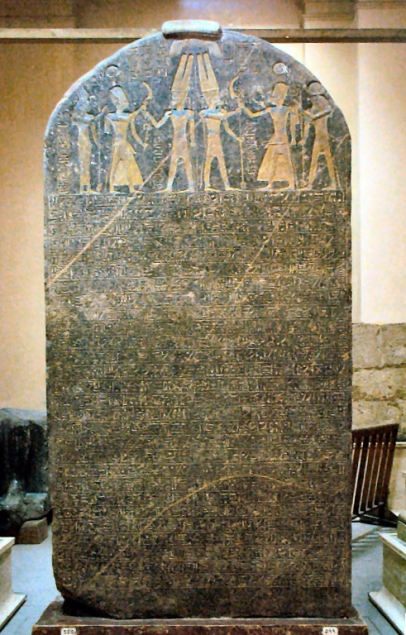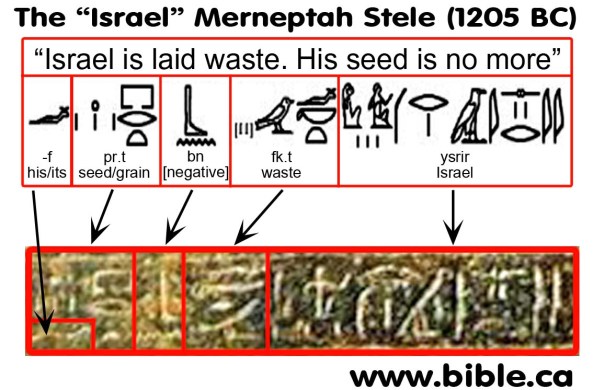
A new year has come and with it new biblical treasures to be mined! The Sands of Time series is Frontiers*nova’s portal to all evidence that God has left us of the reality of events detailed in His word. The feedback on this series has been a great encouragement, but the research itself has proved a blessing to my faith as well, causing me to constantly evaluate my thoughts and everyday lifestyle: am I a living testimony of the truth of what the Bible says happened in my world? Last month’s entry, Bethlehem, is just that: a living witness. The ancient birthplace of Jesus Christ is a modern day gem that takes undaunted, vivacious breaths in the 21st century as a bustling town filled with many archaeological sites, wonders that attract many Christian pilgrim’s to this day. However, for January of 2020 we’ll go in the opposite direction, opening a door that transports the curious 3200 years back in time to ancient Egypt: to the Merneptah Stele.

In another time, a desperate man at the end of his rope, found himself wrestling with a mysterious being in the wilderness at dawn. The being shared the likeness of a man, but Jacob knew that this person was so much more. Telling the stranger that he would not let him go unless he received a blessing, the combatant granted the request to Jacob and renamed him Israel: “he who struggles with God” (Genesis 32: 22-32) From that fateful day, the patriarch of the Israeli people fathered many children, tribes that grew into a populous ethnic group and eventual nation. Amazing, then, that in the modern era many have doubted the bible’s account of Israel himself, even though his seed is spread across the world, with many of them inhabiting the country of, you know, Israel.

That is, until the Merneptah Stele was unearthed in 1896. Discovered by British Egyptologist Flinders Petrie in Thebes Egypt, the find is of great biblical and ethnic significance because it is the earliest textual reference to “Israel”, as well as the only one from ancient Egypt. That means that Israel was mentioned in a non Judeo-Christian text over 1500 years before a Christian bible was ever printed, and 630 years before the Jewish Old Testament of the bible: the “Tanakh”. Flinders himself later declared at dinner with his translator that it would be his greatest achievement, and he was right, as the artifact is now also known as the “Israel Stele”.

The stele, a 10 ft (3 meters) tall slab of granite, was created in 1208 B.C. by the Pharaoh Merneptah. It displays a scene at the top depicting the god Amun handing the king a sword who is being supported by two other gods–iconography that was common in these classic periods of history. Many kings and queens saw themselves as receiving divine authority from gods, if they weren’t considered deities themselves. The surface is incredibly rough, as the stone was “borrowed” from the monument of a previous monarch, Amenhotep III, and its backside used to record Merneptah’s celebration: a fact that I find petty yet humorous.
But what does it actually say? The occasion for recording such annals was the same shared by most rulers in the ancient middle-east and Levant: boasting victory over other nations. The 28 lines, which took considerable effort to translate due to the aforementioned surface, speak mostly of Merneptah’s successful battles against an invading Libyan king and his allies: a confederacy of sea-faring peoples that remain unidentified by the scholarly community. However, the last lines, 26-28, shift the focus to Canaan: the land that God promised His people and that they inhabit to this day.
The translation reads:
“…the princes are prostrate, saying, “Peace!”
Not one is raising his head among the Nine Bows.
Now that Tehenu (Libya) has come to ruin,
Hatti is pacified;
The Canaan has been plundered into every sort of woe:
Ashkelon has been overcome;
Gezer has been captured;
Yano’am is made non-existent.
Israel is laid waste and his seed is not;
Hurru is become a widow because of Egypt.”

When the translators saw the Egyptian hieroglyphs, the strange writing read “I.si.ri.ar”, confirming their wildest dreams, not to mention winning over scholarly consensus today. It is also interesting that Israel was referred to as a man here– when it says “and his seed”. Was this just hyperbole for speaking of the waste of the Israelite nation or was the Pharaoh aware of the culture and history of Israel: that they did indeed trace their lineage back to one revered patriarch? It is also possible that Israel himself was already known in Egypt, his son Joseph having risen in status in the employ of their monarchy centuries before. No one knows for sure, but one thing is certain: Israel, the man who would not let God go until he blessed him, was also blessed with the enduring proof of his seed’s existence from over 3000 years ago resurfacing in the modern age. His name, his struggle and blessing will never be lost to the sands of time. You can find the Merneptah Stele in the Cairo Museum in Egypt. Here’s to a Happy New Year of reinvigorated exploration. Keep on digging!